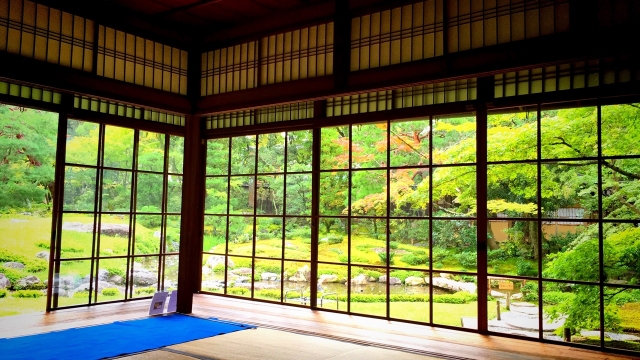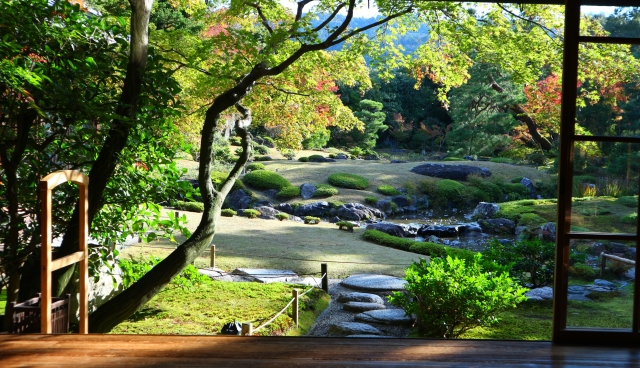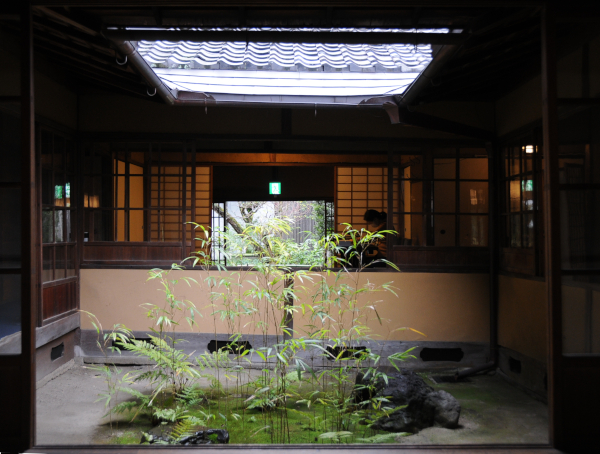One of the many designated places of scenic beauty in Kyoto is the garden of Murin-an near Nanzen-ji temple. Built in 1894-96, the villa with its garden give us a glimpse into upper-class lifestyle of the Meiji era. Murin-an is one among many garden villas in Okazaki, but the only one that is open throughout the year, and yet, it is mostly overlooked by tourists visiting the area.

The name Murin-an means No Neighbor Hermitage, and when it was built in the mid-Meiji period, this was largely true. Of course, there was Nanzen-ji to the east of it, but many of the daimyo’s villas that stood there before the Meiji Restoration had been abandoned or demolished by that time. With the opening of the Lake Biwa Canal in 1890, the area was redeveloped, however, landmarks like the Kyoto City Zoo (1903), the Prefectural Library (1909) and the Municipal Museum of Art (1928) shaped Okazaki then and to this day.
Anyway, back to Murin-an. It was built for and partially designed by Prince Aritomo Yamagata, a top politician and twice prime minister of the Meiji and Taisho eras. He was born in today’s Yamaguchi Prefecture and wanted to recreate the rural landscape of his home in Kyoto. While he had a knack for garden design and made some very unusual choices for Murin-an, he hired one of the top garden designers of his age to shape his vision: Jihei Ogawa VII.

Jihei Ogawa was born in 1860 and became the head of the Ogawa family – garden designers for generations – at the age of 19. Some 15 years later, he was already famous. He would create gardens for a number of villas in the Nanzen-ji area, as well as the Heian shrine gardens and Maruyama Park. But because of Yamagata’s influence, Murin-an became a very special work.
First, the most unusual feature of Murin-an is its flowing stream that adds a certain liveliness where typical Japanese gardens prefer the quietude of a pond. The water springs from a large waterfall at the back and crosses the whole garden before being piped underneath the street to the neighbor’s property.

The second focal point of Murin-an is the large expanse of grass at the center of the garden. Or rather: Yamagata wanted it to be grass, but Kyoto’s ubiquitous moss eventually overpowered the grass. In any case, the center of the garden is rather empty and gives the illusion of a seemingly endless space.
This illusion is only underscored by the borrowed landscape of the Higashiyama mountains that visually close the garden at its eastern side. Although the surrounding trees cannot shut out the noise of the adjacent street, they are meticulously trimmed so that none of the surrounding buildings can be seen from the best viewing spot – the main house.

The main building of Murin-an is a beautiful traditional Japanese house. Its two largest rooms have tatami and floor-to-ceiling glass doors that allow for a full view of the garden, even more so in summer, when they are entirely removed. There is another large room on the second floor, but it is not always accessible, and the view is somewhat impeded by the boughs of a large tree.

Of course, a Japanese garden is not complete without a tea house. The one at Murin-an is a replica of a famous tea house that the tea master Furuta Oribe is said to have favoured. Occasionally, special tea ceremonies are held in the tea house, but in general, it is not accessible to the public.

Prince Yamagata was for a time educated in Europe, and to follow current fashion, he also had a Western-style house built at Murin-an. The second floor shows an interesting mix of Japanese wall paintings and Western upholstery and even has central heating. This room saw one of the most decisive events of Japan’s history: In April 1903, Japan’s prime and foreign ministers met with Yamagata and Ito Hirobumi, another elder statesman, to discuss the deteriorating relationship with Russia. Although the details are unknown, this “Murin-an Conference” set the scene for the Russo-Japanese War that began in 1904. While the second floor room has been preserved in the state of that date, the first floor gives an overview of the garden and its current management.

But the main attraction of Murin-an remains the garden with its many small details. Follow the paths all the way up to the waterfall. Look for the large round stepping stones that are said to provide the best views. Read the inscription on the memorial of the Meiji Emperor presenting Yamagate with two trees for his garden (and see if you can find where they once stood). And marvel at the enormous rock that Yamagata secured for the garden, some 300 years after Toyotomi Hideyoshi had attempted the same – and failed. But above all, take some time to relax and enjoy Murin-an as a peaceful retreat from the busy world outside.
Note that thanks to Corona, a visit to Murin-an currently requires a reservation at least one day in advance. See the Murin-an homepage: https://murin-an.jp/en/

Your house looks really nice after the renovations! 😉 😉 😉
Congratulations!
LOL
I wish…